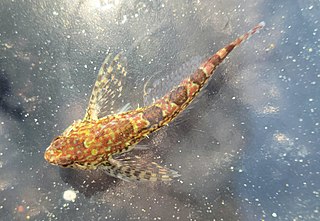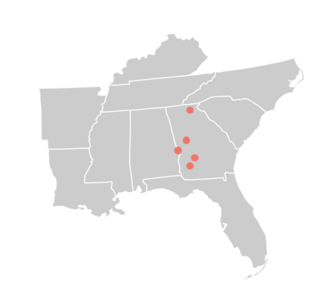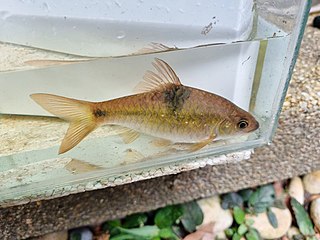
Hoverflies, also called flower flies or syrphids, make up the insect family Syrphidae. As their common name suggests, they are often seen hovering or nectaring at flowers; the adults of many species feed mainly on nectar and pollen, while the larvae (maggots) eat a wide range of foods. In some species, the larvae are saprotrophs, specifically detritivores, eating decaying plant and animal matter in the soil or in ponds and streams. In other species, the larvae are insectivores, preying on aphids, thrips, and other plant-sucking insects.

The corn snake, sometimes called red rat snake is a species of North American rat snake in the family Colubridae. The species subdues its small prey by constriction. It is found throughout the southeastern and central United States. Though superficially resembling the venomous copperhead and often killed as a result of this mistaken identity, the corn snake lacks functional venom and is harmless. The corn snake is beneficial to humans because it helps to control populations of wild rodent pests that damage crops and spread disease.

The white-tailed ptarmigan, also known as the snow quail, is the smallest bird in the grouse tribe. It is a permanent resident of high altitudes on or above the tree line and is native to Alaska and the mountainous parts of Canada and the western United States. Its plumage is cryptic and varies at different times of the year. In the summer it is speckled in gray, brown and white whereas in winter it is wholly white. At all times of year the wings, belly and tail are white. The white-tailed ptarmigan has a diet of buds, leaves, flowers and seeds. The nest is a simple depression in the ground in which up to eight eggs are laid. After hatching, the chicks soon leave the nest. At first they eat insects but later move on to an adult diet, their mother using vocalisations to help them find suitable plant food. The population seems to be stable and the IUCN lists this species as being of "Least Concern".

The saddlebacks or tīeke (Māori) are two species of New Zealand birds of the family Callaeidae. Both are glossy black with a chestnut saddle. Their taxonomic family is also known as that of the "wattlebirds" and includes the two species of kōkako, and the extinct huia. All members of the family Callaeidae have coloured fleshy wattles on either side of the beak; the saddlebacks' are a vivid red.

The brown-mantled tamarin, also known as Spix's saddle-back tamarin, is a species of saddle-back tamarin. This New World monkey is found in the Southern American countries of Bolivia, Brazil and Peru. This omnivorous member of the Callitrichidae family is usually found in smaller groups ranging between 4 and 15 individuals. This species communicates vocally and largely rely their olfactory system. The brown-mantled tamarin is considered as a species of Least Concern by the International Union for Conservation of Nature, despite a decreasing population and being threatened by poaching, habitat loss and capture for the illegal pet trade.

Mantella are a prominent genus of aposematic frogs in the family Mantellidae, endemic to the island of Madagascar. Members of Mantella are diurnal and terrestrial, with bright aposematic coloration or cryptic markings.

The gag grouper, also known as velvet rockfish, the gag, or charcoal belly, is a species of marine ray-finned fish, a grouper from the subfamily Epinephelinae which is part of the family Serranidae, which also includes the anthias and sea basses. It comes from warmer parts of the West Atlantic, including the Caribbean and Gulf of Mexico. It is a drab, mottled-gray fish lacking the distinguishing features of most other groupers. Its pattern of markings resemble the box-shaped spots of the black grouper. It lacks the streamer-points on the tail fin that scamp and yellowmouth grouper have and lacks yellow coloration around the mouth.

Amphiprion polymnus, also known as the saddleback clownfish or yellowfin anemonefish, is a black and white species of anemonefish with a distinctive saddle. Like all anemonefishes it forms a symbiotic mutualism with sea anemones and is unaffected by the stinging tentacles of the host anemone. It is a sequential hermaphrodite with a strict sized-based dominance hierarchy: the female is largest, the breeding male is second largest, and the male non-breeders get progressively smaller as the hierarchy descends. They exhibit protandry, meaning the breeding male will change to female if the sole breeding female dies, with the largest non-breeder becomes the breeding male.

The saddleback caterpillar is the larva of a species of moth native to eastern North America. It is also found in Mexico. The species belongs to the family of slug caterpillars, Limacodidae.

Hemaris thysbe, the hummingbird clearwing, is a moth of the family Sphingidae (hawkmoths). Coloration varies between individuals, but typically the moth is olive green and burgundy on its back, and white or yellow and burgundy on the underside. Its wings are transparent with a reddish-brown border. It has light-colored legs, which combined with the lack of striping on the underside is diagnostic. Beating its wings rapidly, H. thysbe hovers to collect nectar from a variety of flowers. The combination of its appearance and its behavior commonly leads to it being confused with a hummingbird or bumblebee.
The whitefin swellshark is a species of catshark, belonging to the family Scyliorhinidae, endemic to southeastern Australia. It is found 126–554 m (413–1,818 ft) down, on the outer continental shelf and upper continental slope. Reaching 1.1 m (3.6 ft) in length, this shark has a very thick body and a short, broad, flattened head with a large mouth. It is characterized by a dorsal color pattern of dark saddles and blotches over a brown to gray background, and light fin margins. When threatened the whitefin swellshark can inflate itself with water or air to increase its size. Reproduction is oviparous. As of 2019 The International Union for Conservation of Nature (IUCN) has assessed this species as Critically Endangered due to the significant decline of the population.
The flagtail swellshark is a little-known species of catshark, belonging to the family Scyliorhinidae, found at a depth of 480–700 m (1,570–2,300 ft) off northeastern Queensland, and possibly also nearby islands. This stout-bodied shark has a short, broad, and flattened head with a capacious mouth. Adults have a variegated brown coloration with 9–10 darker dorsal saddles and V-shaped blotch at the tip of the upper caudal fin lobe. Juveniles are yellow with narrow brown bars instead of saddles, and a distinctive marking between the spiracles shaped like two loops connected by a line. Like other swellsharks, this species can inflate its body when threatened.

The painted frogfish, or spotted frogfish, black angler or painted anglerfish is a species of marine ray-finned fish belonging to the family Antennariidae, the frogfishes. This species is found in the Indo-Pacific region.

Anolis stratulus is a moderately-sized species of anole found in Puerto Rico, the United States Virgin Islands and the British Virgin Islands. It is a gray-colored lizard spotted with brown markings. It is arboreal, usually found positioned on tree bark on branches in the canopies of forest trees, where in some areas of Puerto Rico it can be incredibly abundant, with tens of thousands of the lizards being present per hectare.

The North Island saddleback is a forest-dwelling passerine bird species endemic to the North Island of New Zealand. It was once considered conspecific with the South Island saddleback. The IUCN lists the species as Near Threatened, while it is listed as a "recovering" species in the New Zealand Threat Classification System. Saddlebacks are known in Māori as tīeke.

Potato leafhopper belongs to family Cicadellidae and genus Empoasca within order Hemiptera. In North America they are a serious agricultural pest. Every year millions of dollars are lost from reduced crop yields and on pest management. Crops that are impacted the most are potatoes, clover, beans, apples and alfalfa.

The saddleback sculpin is a species of fish in the sculpin family Cottidae. It is known to inhabit the North American shore of the Pacific Ocean. It is a very understudied fish with limited knowledge of behavioral patterns, lifecycle and reproduction.

The Halloween darter is a small freshwater fish native to North America. It is found in Georgia and Alabama in the drainage basin of the Apalachicola River, specifically in the Flint River system and the Chattahoochee River system. It prefers shallow, fast-flowing areas with gravel bottoms in small and medium-sized rivers. It was first described in 2008, having not previously been distinguished from the Blackbanded darter (P. nigrofasciata), formerly thought to occur in the same watershed. Blackbanded darter has since been split again with Westfall's darter now recognised from the Apalachicola drainage. The species is somewhat variable, being generally blackish dorsally, with some individuals having indistinct saddle-like barring. Males have orange and dark lateral striping while females have dark stripes and a yellowish-green belly. At a maximum standard length of 101 mm (4 in), males are slightly larger than females, and both sexes develop distinctive orange barring on the edge of the first dorsal fin during the breeding season.

The saddleback gunnel, also known as the saddled blenny, is a species of marine ray-finned fish belonging to the family Pholidae, the gunnels. This fish occurs in the shallow coastal waters of the eastern North Pacific Ocean.

Barbodes sellifer, the saddled barb, is a species of cyprinid fish described in 2021. This species has not been reported sold in the aquarium trade, but where the species is present reports of them being kept by aquarists are abundant.


















